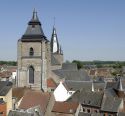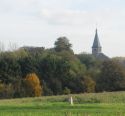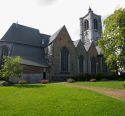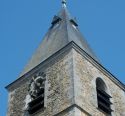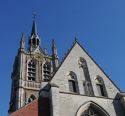The Middle Ages in the Haute Senne region (full circuit)
The Open Churches network invites you to discover the medieval period by visiting various churches in the Haute Senne region. Proudly erected for centuries, they are the witnesses of local history. Together with castles and farms, these places of worship tell the story of an era and its customs.
Throughout the tour, you will follow a small character, "nameless and ageless". He will take you to the lands of Hainaut County. For you, he will meet historical and legendary characters from the region.
In Soignies, you will discover the Romanesque collegiate church and meet Saint Vincent. At Chaussée-Notre-Dame, it is the Lady of the Area who awaits you. But before you get there, you can admire the landscape of the Haute-Senne: stretches of fields, a few groves and beautiful buildings along the roads. In Horrues, a small village high up, you will know more about Saint Martin, Saint Hubert and their fetish animals. Before leaving the village, the Chocolaterie au Manon D'Hor will offer you its best praline. The walk will then take you in the footsteps of Baudouin IV the Builder, to Braine the Count. You will then follow the valley of the Brainette to Steenkerque, the village of the mills and Guillaume de Gavres, lord and watchman of the church. On the road to Petit-Enghien, you can admire the oldest mill still in operation at the Pont Tordoir. After visiting the church of the Holy Savior, it is the medieval city that awaits you. You will have the opportunity to meet Jonathas, Saint Eloi, and the Lords of Enghien before finishing the walk in the park.
This route is more fully described in a discovery brochure The Middle Ages in the Haute Senne region.
Download PDF Continue on mobile
-
collegiate church Saint-Vincent - Soignies
At the time, Soignies was only a small village of little importance. The construction of such a collegiate church is disproportionate to local needs. Disproportionate in a green landscape, you can see it for miles around! (...)
-
Church of the Virgin Mary - Chaussée-Notre-Dame
-
church Saint Martin - Horrues
One of the largest villages in the country, established on a promontory overlooking the Senne, Horrues has always maintained a very strong link with Soignies and its collegiate church. The church overlooks the whole village (...)
-
Church Saint-Géry à Braine-le-Comte
The small town of Braine-le-Comte takes its name in part from the Brainette, a river that originates in the nearby Bois de la Houssière and flows into the Senne a few kilometres further on, at Steenkerque. This entity was then called Braine-la-Wilote and was part of the possessions of the canons of Sainte-Waudru (...)
-
Church Saint-Martin - Steenkerque
It is a small village lost on a small rocky promontory overlooking the Senne. Life has always been peaceful there, like a long quiet river. Although... (...)
-
Mill
Here is a real mill certified since the end of the Middle Ages. The landscape has a hilly character, which gives a high flow to the rivers, ideal for developing a milling industry. The miller supplied the lord and his subjects with flour and oil (...)
-
Church Saint-Sauveur - Petit Enghien
Petit Enghien is not as small as you might think... Indeed, this village is twenty times larger than the area of the town of Enghien. And even older, the Romans had already passed through it: the Chaussée de Brunehaut, linking Bavay to Utrecht, is just next door (...)
-
Church Saint-Nicolas d'Enghien
In the centre of the town square, the church stands proudly in all its grandeur. The existence of a place of worship dates back to the 12th century, in line with the arrival of the lords of Enghien. Victim of fires, the building was rebuilt in the style of the time: Gothic (...)
-
Jonathas House in Enghien, the Dungeon, Tapestry Museum
Not far from the church of St. Nicholas stands the House of Jonathas. According to popular legend, it is known as Jonathas' residence, but also as the former dungeon of the city's primitive castle. However, this "fortification" is more like a tower-house, one of those built by the lords in the 12th and 13th centuries (...)
-
Castle chapel of Enghien Park
The itinerary is coming to an end. You can end the tour with a walk in the sumptuous Enghien Park, the former residence of the local lords (...)


